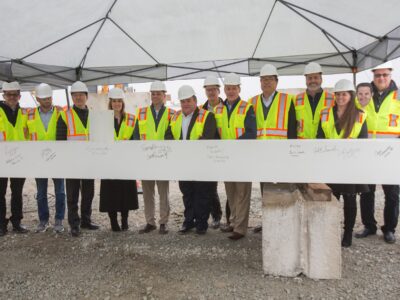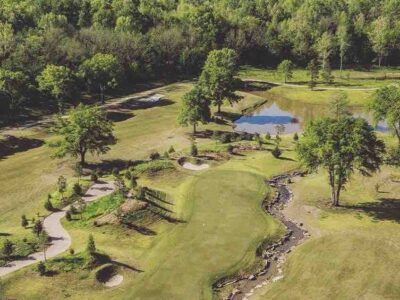Northern Ohio: Exciting hotbed of innovation at the intersection of American manufacturing and clean energy? Some Americans might be skeptical, but from EV batteries to solar panels, innovators like GM, LG, and First Solar are designing cutting-edge technologies near the coastline…of Lake Erie. While the region’s future role in the clean energy transition is important, the Cuyahoga Valley Episode of Farms Across America reminds us that restoring natural ecosystems and using age-old regenerative agricultural practices is critical to the region’s sustainable future, not to mention the country’s.
The Cuyahoga Valley is one of the most underrated natural areas in the US (outside of Ohio). Its river winds through 33,000 acres of protected land. Most of this preserve is forested, but there are also biodiverse wetlands like Beaver Marsh, where visitors might observe otters and blue herons fishing among floating lily pads. The jewel of the valley is Brandywine Falls where the waterfall cascades over rugged sandstone steps before feeding into an offshoot of the Cuyahoga River. In the winter, the falls often freeze, creating a spectacular natural sculpture with jagged icicles hanging from each step. The traces of a vibrant pastoral tradition can still be found throughout the valley. Historic farmsteads and artificial agricultural lakes dot the landscape while bikers can ride along the ruins of the Ohio and Erie Canals. Entering the valley almost feels like stepping out of a time machine as one can witness what pre-industrial Ohio would have looked like.
Many historically overlooked the Rust Belt’s ecological significance, focusing instead on its essential role in American industrialization. But Ohio’s campaign to help the Cuyahoga Valley attain National Parks status marked a milestone. It is often studied as the spark to a movement to protect underappreciated natural regions (for example, the Indiana Dunes National Park or West Virginia’s New River Gorge). Here are a couple of key takeaways from one of the most successful environmental rehabilitation projects in American history and from the work of the modern-day farmers who are honoring its legacy:
Seemingly Impossible Obstacles inspire the Greatest Innovators: When faced with a considerable, complex challenge, the best problem solvers remain optimistic and view the situation as an opportunity to impact the world. The restoration of the Cuyahoga River and the region more broadly exemplifies the power of this positive mindset. By 1969, it seemed like everyone had given up on the health of the Cuyahoga River, which was filled with oil, sewage, and other pollutants. However, rather than being overwhelmed by the extreme scope of this environmental challenge, a group of committed local and federal leaders from across the political spectrum was energized. The community recognized that only a massive, collaborative effort could save the region from further environmental damage, and they believed they were up for the task.
We have two critical legacies from this massive rehabilitation: the Environmental Protection Agency (EPA) and the Clean Water Act. These innovations created new water quality standards and agency resources to restore ecosystem health all over America. In Ohio, the public sector’s efforts led to the Cuyahoga Valley’s designation as a National Park at the turn of the 21st century. This move bolstered efforts to purify the river’s water by decontaminating toxic waste sites, removing dams, and planting riverbank vegetation. These initiatives have been so effective that most sections of the river currently meet the standards of the Clean Water Act, allowing the iconic bald eagle to nest along its banks once again. All this progress would not have been possible if the group of public sector innovators had given up when times were tough. But, they had a vision of a better Ohio and worked tirelessly to make this dream a reality. There are even a few parallels to today. Faced with the changing climate, individuals from across the country and party lines follow this solution-oriented example to address one of the greatest needs of the modern era. Public sector leaders worked together to pass meaningful legislation that sets us on a path of environmental improvement. And, without hope, it is easy to see how we could give up and give in to political polarization and tribalism.
Family Farms Can Serve as a Sustainable Example For American Agriculture: Small farms can be a vehicle to remind all farmers about these practices and inspire them to make a change. Northeast Ohio is one such area that is committed to this mission. Local leaders knew that resurrecting the area’s farming tradition would provide Ohioans with better-quality produce while also serving as a sustainable example for the rest of the agricultural sector to follow. They created the groundbreaking Countryside Initiative Program, which allowed Cuyahoga to become the first National Park to lease land to farmers. This project reestablished 14 historic farmsteads whose owners would utilize original farming practices. Melissa and Mike Keleman run one of these farms. Their operation is an exemplary model of sustainable agriculture as they raise heritage-breed livestock, grow fresh produce, and fertilize their soil using natural methods. The property’s pastures even help reduce the region’s carbon footprint by absorbing 72 tons of CO2 annually. If these regenerative practices are reproduced nationally, experts at the National Academy of Sciences forecast that 250 tons of carbon can be captured annually. The Kelemans are contributing to this goal of widespread adoption by teaching visiting families the principles of sustainable farming through their “ABC Garden,” in which they show children how to take care of crops and feed themselves. Melissa described their mindset best: “We’re trying to bring back that old lifestyle. That skill set is what we want for this community, for our children.”
Don’t Let Initial Inexperience Prevent You From Your Dreams: Years of formal education and direct industry experience are not always prerequisites for entrepreneurial success. A combination of passion, a strong work ethic, a willingness to learn, and the ability to surround oneself with the right mentors often builds the necessary foundation for any business endeavor. Just look at the 30% of billionaires who generated their wealth without the assistance of a college degree. Before moving into the Cuyahoga Valley, the Kelemans had no agricultural experience. Still, they convinced the National Parks that they could run both an environmentally sustainable and economically viable farmstead. They began by tirelessly drafting their 127-page proposal that displayed their enthusiasm and ability to learn quickly. The Kelemans knew that they could not put this plan into action alone. So, they tapped into their neighbors’ wealth of experiences to help hasten their learning process and worked closely with their predecessors for support and guidance.
To this day, I keep regular contact with many mentors who have helped teach and mold my professional perspective over the last two decades. Without watching (and satisfying) my final formal “boss” start his firm, I would not have been exposed to many critical lessons. And I keep in touch with him and other previous colleagues to continually get smarter and challenge my thinking as I build.





